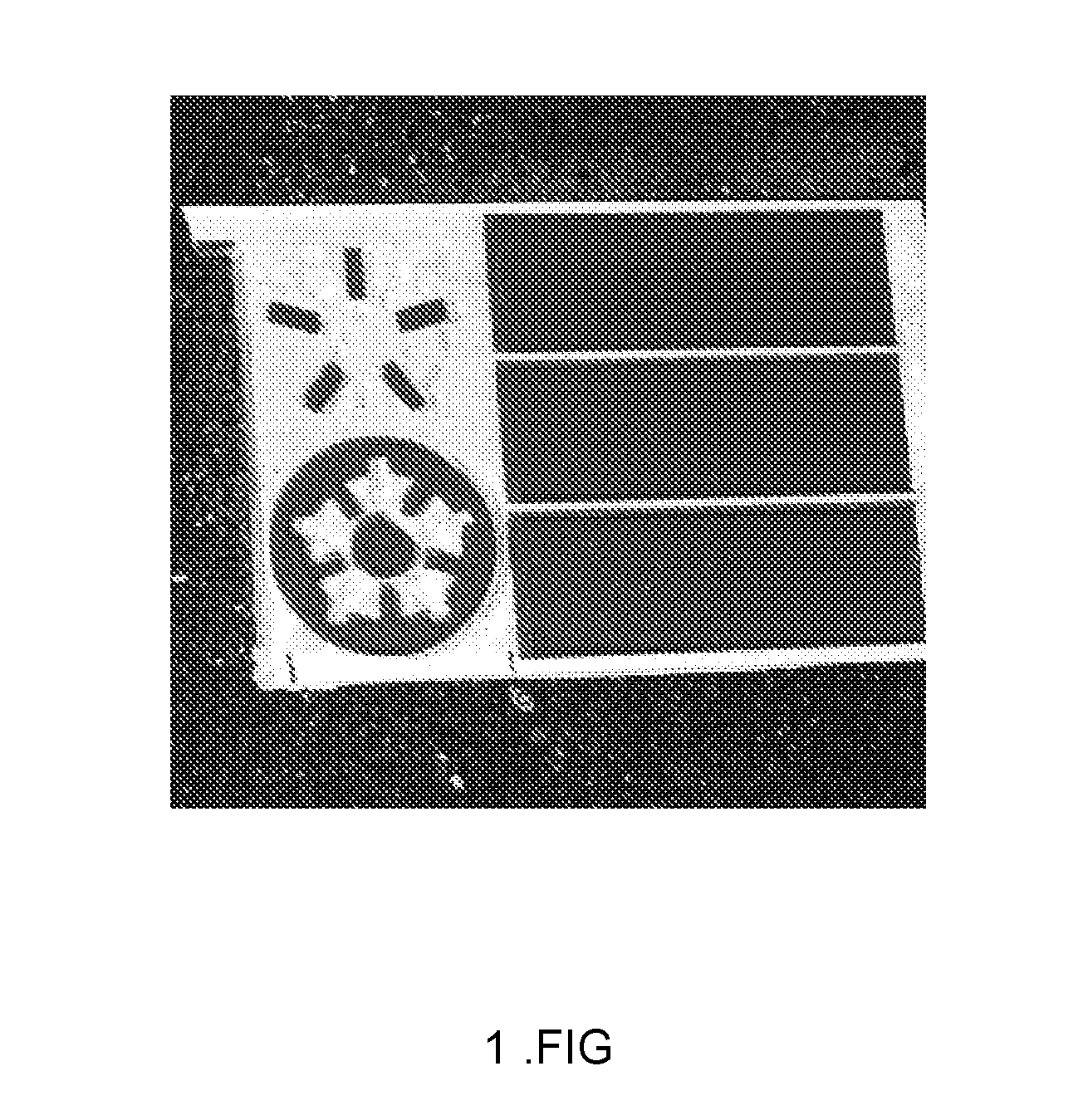Support ink for three dimensional (3D) printing
a technology of support ink and printing ink, which is applied in the field of printing support ink, can solve the problems of difficult to completely remove the support, and difficult for the formed water soluble support polymer to maintain its dimensions and 3d structure at high temperatures
- Summary
- Abstract
- Description
- Claims
- Application Information
AI Technical Summary
Benefits of technology
Problems solved by technology
Method used
Image
Examples
example 1
Titania Support
[0082]An ink formulation comprised of Titania (TiO2). particles was prepared by mixing a dispersion of titania nanosize particles (approximately 20 nm to approximately 250 in liquid carrier, with surface modifying agents in the following amounts:
Weight (gr)Weight %100.0026.66Rutile titania (Kronos)7.52.05Disperbyk 190 (DispersingAgent)2.50.68Butvar B-90 (SurfaceModifier)265.070.66DPM (dipropylene glycolmethyl ether) (CarrierVehicle)375.0Total FormulationInk property15.0 ± 5.0Viscosity (cPs), 25° C.29.0 ± 2.0Surface tension, 25° C.
[0083]A Titania (TiO2) dispersion was prepared by dispersing 50±2 wt % rutile Titania powder (Kronos 2064, a nanopowder) in glycol ethers and stabilized with a polymeric dispersant (3 wt % of the solid particles). All components were mixed in a vertical agitator (vertical agitator mill) filled with 0.8 mm ZrO2 beads and a volume ratio of 67 / 33 (beads / product; vol / vol) for 6 hours at 15° C. Titania ink was prepared by diluting the preformed, h...
example 2
[0085]Calcium Sulfate ink was prepared by the following steps:[0086]a. Solid Anhydrous Calcium sulfate (CaSO4) was ground in an agitator mill in Glycol Ether (e.g., DPM) solvent mixture with a combination of ionic (e.g., SLS) (approximately 7.5 wt %) and polymeric (e.g., Disperbyk 190) (approximately 6 wt %) dispersants to form a stable dispersion that passed a 3 μm mesh filtration).[0087]b. Polymeric additives (polybutyral, e.g., Butver B-90, approximately
[0088]CaSO4 of the Calcium Sulfate Support Ink is water soluble, after printing by the techniques of Example 1, and heating the object under vacuum in an oven, the oven heated to approximately 1000° C. The resultant object with support ink was washed with water in order to separate (by partially dissolving) the support ink from the object
Weight (gr)Weight %100.0032.73Calcium sulfate7.02.3Disperbyk 190 (DispersingAgent)8.672.83SDS (Dispersing Agent)5.781.9Butver B-90 (SurfaceModifier)184.070.66DPM (Carri...
example 3
[0089]The use of cobalt free carbide support has an advantage due to the fact that it is as similar to the object material as possible. This inhibits cross contamination between the two printed materials (3D object and support). The Tungsten Carbide (WC) dispersion was prepared by dispersing 55±2 wt % Tungsten Carbide (WC) powder (0.8 micron, as milled from WC particles available from General Carbide Corporation, Greensberg, Pa., USA) in glycol ethers, e.g., DPM in the table below, and stabilized with a polymeric dispersant e.g., Disperbyk 163 (5 wt % on WC particles), listed as the “WC Dispersion” in the table below. All components were mixed in a vertical agitator (vertical agitator mill) filled with 0.5 mm WC beads and a volume ratio of 67 / 33 (beads / product; vol / vol) for 6 hours at 15° C., in accordance with the following table:
Metal (gr)Weight (gr)160.0290.00WC dispersion (55% metal)30.0DPM and DEGBE mix (1:1wt %) (Carrier Vehicle)160.0320Total Formul...
PUM
| Property | Measurement | Unit |
|---|---|---|
| weight percent | aaaaa | aaaaa |
| weight percent | aaaaa | aaaaa |
| weight percent | aaaaa | aaaaa |
Abstract
Description
Claims
Application Information
 Login to View More
Login to View More - R&D
- Intellectual Property
- Life Sciences
- Materials
- Tech Scout
- Unparalleled Data Quality
- Higher Quality Content
- 60% Fewer Hallucinations
Browse by: Latest US Patents, China's latest patents, Technical Efficacy Thesaurus, Application Domain, Technology Topic, Popular Technical Reports.
© 2025 PatSnap. All rights reserved.Legal|Privacy policy|Modern Slavery Act Transparency Statement|Sitemap|About US| Contact US: help@patsnap.com

